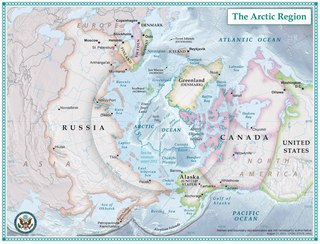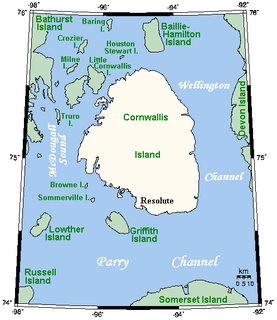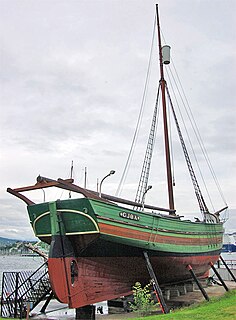
The Northwest Passage (NWP) is the sea route between the Atlantic and Pacific oceans through the Arctic Ocean, along the northern coast of North America via waterways through the Canadian Arctic Archipelago. The eastern route along the Arctic coasts of Norway and Siberia is accordingly called the Northeast Passage (NEP).

The Arctic is a polar region located at the northernmost part of Earth. The Arctic consists of the Arctic Ocean, adjacent seas, and parts of Alaska, Canada, Finland, Greenland (Denmark), Iceland, Norway, Russia, and Sweden. Land within the Arctic region has seasonally varying snow and ice cover, with predominantly treeless permafrost containing tundra. Arctic seas contain seasonal sea ice in many places.

RV Polarstern is a German research icebreaker of the Alfred Wegener Institute for Polar and Marine Research (AWI) in Bremerhaven, Germany. Polarstern was built by Howaldtswerke-Deutsche Werft in Kiel and Nobiskrug in Rendsburg, was commissioned in 1982, and is mainly used for research in the Arctic and Antarctica. The ship has a length of 118 metres and is a double-hulled icebreaker. She is operational at temperatures as low as −50 °C (−58 °F) Polarstern can break through ice 1.5 m thick at a speed of 5 knots. Thicker ice up to 3 m (9.8 ft) thick can be broken by ramming.

The Northeast Passage is, from the European and northern Atlantic point of view, the shipping route to the Pacific Ocean, along the Arctic coasts of Norway and Russia. The western route through the islands of Canada is accordingly called the Northwest Passage (NWP).

Sir John Franklin was a British Royal Navy officer and Arctic explorer. After serving in wars against Napoleonic France and the United States, he led two expeditions into the Canadian Arctic, in 1819 and 1825, and served as Lieutenant-Governor of Van Diemen's Land from 1839 to 1843. During his third and final expedition to force the Northwest Passage in 1845, Franklin's ships became icebound off King William Island in what is now Nunavut, where he died in June 1847. The icebound ships were abandoned ten months later and the entire crew died, from causes such as starvation, hypothermia, and scurvy.

HMS Resolute was a mid-19th-century barque-rigged ship of the British Royal Navy, specially outfitted for Arctic exploration. Resolute became trapped in the ice and was abandoned in 1854. Recovered by an American whaler, she was returned to Queen Victoria in 1856. Timbers from the ship were later used to construct the Resolute desk which was presented to the President of the United States and is currently located in the White House Oval Office.

RCMPVSt. Roch is a Royal Canadian Mounted Police schooner, the first ship to completely circumnavigate North America, and the second vessel to transit the Northwest Passage. She was the first ship to complete the Northwest Passage in the direction west to east, going the same route that Amundsen on the sailing vessel Gjøa went east to west, 38 years earlier.

In the Canadian Arctic Archipelago, Somerset Island is a large, uninhabited island separated by the 2 km (1.2 mi) wide Bellot Strait from the Boothia Peninsula in the Qikiqtaaluk Region of Nunavut, Canada, lying between Peel Sound and Prince Regent Inlet. It has an area of 24,786 km2 (9,570 sq mi), making it the 46th largest island in the world and Canada's twelfth largest island.

Cornwallis Island is one of the Queen Elizabeth Islands, part of the Arctic Archipelago, in the Qikiqtaaluk Region of Nunavut in the Canadian Arctic. It lies to the west of Devon Island and at its greatest length is about 113 km (70 mi). At 6,995 km2 (2,701 sq mi) in size, it is the 96th largest island in the world, and Canada's 21st largest island. Cornwallis Island is separated by the Wellington Channel from Devon Island, and by the Parry Channel from Somerset Island to the south. Northwest of Cornwallis Island lies Little Cornwallis Island, the biggest of a group of small islands at the north end of McDougall Sound, which separates Cornwallis Island from nearby Bathurst Island.

Gjøa was the first vessel to transit the Northwest Passage. With a crew of six, Roald Amundsen traversed the passage in a three-year journey, finishing in 1906.

HMS Hecla was a Royal Navy Hecla-class bomb vessel launched in 1815. Like many other bomb vessels, she was named for a volcano, in this case Hekla in Iceland. She served at the Bombardment of Algiers. Subsequently she took part in three expeditions to the Arctic. She then served as a survey vessel on the coast of West Africa until she was sold in 1831. She became a merchantman and in 1834 a Greenland whaler. She was wrecked in 1840.

HMS Fury was a Hecla-class bomb vessel of the British Royal Navy.

CCGS Louis S. St-Laurent is a Canadian Coast Guard Heavy Arctic Icebreaker. Louis S. St-Laurent's home port is St. John's, Newfoundland and Labrador and is stationed there with other vessels of the coast guard.

SS Manhattan was an oil tanker constructed at the Fore River Shipyard in Quincy, Massachusetts, that became the first commercial ship to cross the Northwest Passage in 1969. Having been built as an ordinary tanker in 1962, she was refitted for this voyage with an icebreaker bow in 1968–69. Registered in the United States at the time, she was the largest US merchant vessel as well as the biggest icebreaker in history.

HMS Griper was a Bold-class gun-brig of the British Royal Navy, built in 1813 by Mark Williams and John Davidson at Hythe. She participated in the 1819 expedition to the Arctic led by William Parry, made a voyage to Greenland and Norway in 1823, and took part in Parry's third expedition in 1824 as a support ship. Her crew in 1819, 1823, or 1824, qualified for the "Arctic Medal", which the Admiralty issued in 1857. She was eventually broken up in 1868.

Franklin's lost expedition was a British voyage of Arctic exploration led by Captain Sir John Franklin that departed from England in 1845 aboard two ships, HMS Erebus and HMS Terror, and was assigned to traverse the last unnavigated sections of the Northwest Passage in the Canadian Arctic. The expedition met with disaster after both ships and their crews, a total of 129 officers and men, became icebound in Victoria Strait near King William Island, in what is today the Canadian territory of Nunavut. After being icebound for more than a year, Erebus and Terror were abandoned in April 1848, by which point Franklin and nearly two dozen others had died. The survivors, now led by Franklin's deputy Francis Crozier and Erebus' captain James Fitzjames, set out for the Canadian mainland and disappeared.

HMS Investigator was a merchant ship purchased in 1848 to search for Sir John Franklin's ill-fated Northwest Passage expedition. She made two voyages to the Arctic and had to be abandoned in 1853, after becoming trapped in the pack ice.

Arctic exploration is the physical exploration of the Arctic region of the Earth. It refers to the historical period during which mankind has explored the region north of the Arctic Circle. Historical records suggest that humankind have explored the northern extremes since 325 BC, when the ancient Greek sailor Pytheas reached a frozen sea while attempting to find a source of the metal tin. Dangerous oceans and poor weather conditions often fetter explorers attempting to reach polar regions and journeying through these perils by sight, boat, and foot has proven difficult.

The McClure Arctic expedition of 1850, among numerous British search efforts to determine the fate of the Franklin's lost expedition, is distinguished as the voyage during which the Irish explorer Robert McClure became the first person to confirm and transit the Northwest Passage by a combination of sea travel and sledging.

















